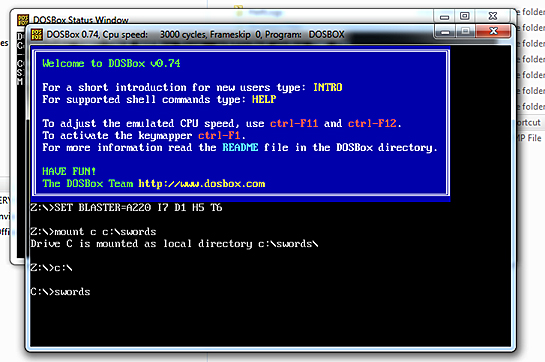

Swords of Glass
Introduction:
Swords of Glass is a classic, some would say archaic, PC game from 1986 in which you explore a series of eight dungeons and evolve characters as you search for the mythical Sword of Glass. By today's standards its wireframe walls and painfully simplistic 3-color non-animated monsters are nothing short of laughable. Yet it has to be acknowledged that in this game lays the seed that grew into today's ubiquitous World of Warcraft. Just as in the online game you go on quests, fight monsters, buy and sell items in a store, learn about them in a temple, rest in a hotel, and in so doing evolve a character into either a warrior or a magician. Set the primitive graphics aside and you have a game that in many ways is every bit as entertaining as modern games.
While enormously outdated by today's standards, Swords of Glass was revolutionary for its time. It was one of the first, if not the very first, game to offer a split screen - multiplayer option, 3D color dungeons, monsters that followed a character if he attempted to run away, equipment that degraded with use, equipment that could be blessed to increase its strength and map randomization so every time you visited an area its layout changed.
My interest in Swords of Glass began in 1987 when I purchased and played it with my son. I can still feel the thrill of excitement when, after two months of painstaking effort, we finally surmounted the last obstacle and captured the Sword of Glass. We continued to explore the various dungeons in the game for months after that but in time, as always happens, interest faded. Decades passed and suddenly I found myself hip-deep in grandsons. Their appearance dredged up long forgotten memories of things I did with my son and one of those was Swords of Glass. Wondering if it was still available, an Internet search turned up an outstanding site by Dean Tersigni (The Glass Shrine) that provides unparalleled detail about the nature and history of the game, complete descriptions of the weapons, spells and potions, as well as descriptions of many of the monsters that inhabit the dungeons. Best of all he provides a free download of the game and a link to a site with a free DOS emulator program on which to run it. I heartily encourage anyone interested in Swords of Glass to visit his site.
Since Dean did such an outstanding job describing the game, I thought a page designed to help people play it would be appreciated. That's what the following page is about: providing maps of all the dungeons, pictures of the various monsters one is likely to encounter and suggestions on playing techniques.
Why should anyone want to play a PC game from the dark ages of computer gaming? There's always nostalgia value for those, like me, who cut their gaming teeth on this classic. It's also instructive to play the game many consider the prototype for World of Warcraft and similar games. Quite apart from these reasons is the fact that this game is still both challenging and satisfying to play. No, it doesn't have the dazzling eye candy of today's games. But in the final analysis it's not a game's look that gets your heart pounding, it's the sense of danger when you've invested weeks or even months building up a character only to discover that you've gotten him a situation that may kill him and in so doing, loose all that invested time and effort. Jeopardy is what makes a great game, and in its own humble way Swords of Glass has it in abundance.
As for the graphics, in today's world they mine unintended humor in that even after playing for hours the ridiculously simple images still make smiling at them irresistible.
How
to Get Started:
The following instructions are how I got Swords of Glass up and running on my computer. The only real trick is in setting up a DOS emulator on which to run the game. If you don't, the game will still run in Windows but the messages that appear on screen when you encounter an artifact, treasure or enemy flash on and off so fast you can't read them.
(For anyone who doesn't know what DOS is, it was what we used to run computers before Windows. It was a very simple text-based system, no pictures or icons. When you turned a computer on all you got was C:\ on the screen. To run a program you typed the program's name and hit return. Groups of related programs and data files were organized into subdirectories, similar in concept to folders. To open one you typed the subdirectories' name preceded by C:\ and hit enter. DOS wasn't much to look at but it got the job done. The great thing about it was that it didn't eat up much in the way of memory and ran blindingly fast even on the 1 megahertz and slower machines back then.)
Step 1 for Running the Game. Read all of Dean Tersigni's webpages dedicated to Swords of Glass (The Glass Shrine.)
Step 2. Download the free version of it available at the bottom of his home page. It ends up as a zipped icon on your desktop. Immediately under this is a link to a page where you can download the DOS emulator software. Get it as well.
Step 3. Download the copy of Doug O'Hara's Vault Editor program at the bottom of Dean's page about Cheating. It'll download as an icon on your desktop.
Step 4. Follow the instructions for installing the DOS emulator on your computer. I had a little trouble doing this so here's how I got everything running:
A. Click on the zipped Swords icon on your desktop and run the installation program. You want to click on the recommended "All Files" option. It'll create a new icon on your desktop.
B. Place your cursor on the Windows "Start" button and click on "My Computer."
C. In "My Computer", click on the "C" drive.
D. In "C", create a folder named "swords" and move all of the Swords of Glass files created in step "A" into it.
E. Move the Vault Editor program into the "swords" folder.
F. Move the DOS emulator icon from your desktop to the "C" drive, but not in the "swords" folder.
G. Click on the DOS emulator icon and install it on the same drive.
You're done and ready to play!
Starting
the Game:
To start playing, double-click on the DOS icon created when the DOS emulator was installed. A window will appear with some text. The last line will be Z:\.
After this type: "mount c c:\ swords" without the quotes and hit enter. A line of text will appear followed by another Z:\. (The first time I tried this I got an error message. Nothing I did fixed it. The next day it worked perfectly and has ever since. I suspect my particular system required a reboot to get things settled.)
After this second Z:\ type "C:\" without the quotes and hit enter. A C:\ will appear.
Type "swords" after it, without quotes. It should look like this:

Hit enter after typing the last "swords." The Swords of Glass cover page will open. Just press "enter" one more time and you are playing the game. The start page looks like this:
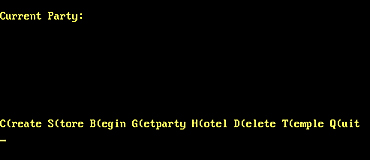
In "Create" you make your character, in "Store" you can buy and sell equipment as well as put it in and take it out of the vault. "Begin" starts play. "Get party" is where you select the character with which you want to play. You can have up to 20 charaters. "Hotel" is where you can rest (heal) and upgrade your charater when he earns another level. "Delete" is for removing unused charaters from the game. Priests in the "Temple" can bless (repair) equipement for a fee and provide some information about equipment. Use "Quit" to save and exit the game. Note: This game was written so long ago it does not use a cursor. Instead, you have to type the letter or number desired to select that item or task.
Selecting a charater and typing "B" dumps you on location 4,19 of level 1. Here is what you'll see:
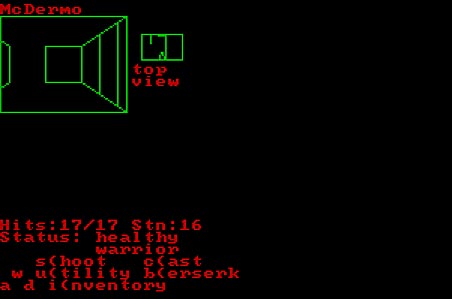
Only the left half of the screen is used because the right side is reserved for a second player. Your charater's name is located at the top left. In this case it was supposed to be McDermot but the program only allows 7 letters for the name so the "T" got chopped off. Pressing "S" opens a window that lets you select a bow to shoot. "C" lets you select which spell to cast. "U" is for utility, from which I only use "N" to speed recovery from being put to sleep or paralyzed. This step may have to be repeated several times to cancel the paralysis but is absolutely necessary. Not doing so means you may have to wait 20 minutes or more for it to time out by itself. "B"erserk is an aggressive attack mode that doubles your strength for a short period of time, then it slowly drains away to a very low number so use it only as a last resort. "I"nventory takes you to a page listing all your equipment and allows you to select one to use. For example, if you are facing a gargoyle you would hit "I," then "U" for use then the letter next to "chisel" to use it to destroy the gargoyle and reveal the door behind it.
"w" caused your character to take one step forward. "a" turns you to the left and "d" to the right.
As already mentioned, hitting "C" opens the spell casting window, which looks like this:
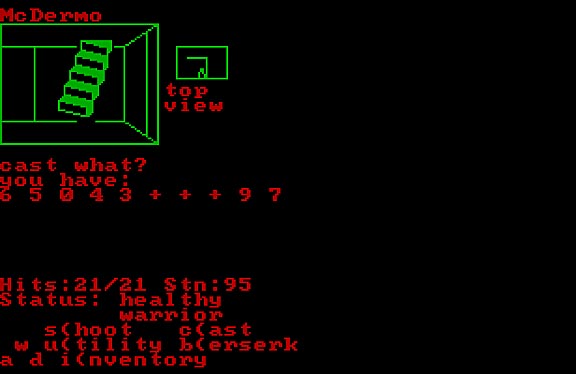
The row of numbers shows how many total spells can be cast from each of the ten levels starting with level 1, the weakest, on the left. A "0" means there are no spells available in that level a "+" means there are 10 or more. To cast a spell type its name and hit "enter." Some spells fire automatically while others will ask you for information. Magicians learn spells as they work their way up through the levels or by reading spell books. Warriors can only learn spells from spell books. The cheating page below explains how to create +9 spell book with hundreds of uses. Since learning spells from a book isn't limited to character level, even low level characters can become spell-casting juggernauts. To do so make a spell book, go into inventory and repeatedly hit "u" and the inventory letter corresponding to the spell book. Sometimes you'll learn a new spell, other times you'll gain magic power, which means you earned another use of a spell. A +9 spell book won't have all available spells but a fixed set. To collect all the spells you'll have to roam around the levels until you find spell books of various levels. A +9 book will provide you with all the critical spells:
Mapa - provides the location of your character and the direction he's facing.
Masfuerza - increases strength by +40 then slowly decreases over 15 minutes.
Masamparo - increases defense by +40 then slowly decreases over 15 minutes.
(These last two mean you don't have to carry around fuerza and amparo potions, opening up two spots in your inventory.)
Masviva - heals most wounds, but I don't think it's as powerful as curall potion.
Pocomudar - teleports you to any place on the level you're currently on.
Mudar - teleports you to any place on any level except to level 8. It works in level 8, you just can't use it to get to that level. I don't know if you can use it to leave that level.
Infierno - A brutal bolt of energy that will kill almost anything.
There
are 23 other spells but the ones above are the most important for
single-player gaming. To find out which spells a character has, take
him to the store and they will be listed on the right side of the screen.
Beware
of Fantasma and Espritu. These allow you to leave your body and look
around without being attacked by monsters. But, I haven't discovered
a way to cancel them when I want. I always have to wait for them to
time out. I'm not sure but I think you have to get back to your body
to come out of them. If you get lost this could be very frustrating
as you roam around looking for a way back.
The following Youtube video by dfortae gives an idea of what the game looks like in actual play. Note: I personally believe this game deserves a better review than this video gives it.
You have to repeat the "mount C:\swords" command sequence every time you want to play the game. This reads like a lot of work to start but it really only takes two seconds. The game appears in a small screen. You can toggle between that and full screen and back again by simultaneously hitting the alt-enter keys.
Playing
Swords
of Glass:
Dean Tersigni has completed an outstanding overview of the game, which I encourage everyone to read. Jamiras (www.gamefaqs.com/pc/986047-swords-of-glass/faqs) has posted a entremely detailed level-by-level playing guide that will make the game must less frustrating as well as a set of the best level maps I've ever seen. If these maps have any fault it's that they provide so much detail that they may spoil the thrill of discovery.
crpgaddict.blogspot.com/2010/09/game-25-swords-of-glass-1986.html and www.hotud.org/component/content/article?id=23641 also have some interesting background information.
The first question a player needs to ask him or herself is whether or not to cheat by using the suggestions Mr. Tersigni provides on his Cheating page. My answer to this question is YES! The reason I firmly believe that it's alright to cheat is that the game cheats too. There are traps scattered throughout the dungeons which, when you walk over them, permanently put you to sleep or paralyze you. No armour, spell, or potion can prevent it or cure it. There are no warnings for these traps. The argument could be made that this is part of the character building challenge and that every time you discover one you can note its location and avoid it next time. The problem with this argument is that in level eight, 60-percent of the dungeon changes every time you enter it. The location of these deadly traps are scrambled and no matter how many times you visit it you can never be sure if the next step you take will be your last. In short, the game has hidden traps that no matter how well prepared and protected you are they will kill you over and over again. I claim that if a game's written so that no amount of preparation and planning can protect you from dying, the game has been set up unfairly. Therefore a little cheating on a player's part is justified.
The next question is: "How much should you cheat?" As a minimum I believe that saving your character in a backup of the "People.dat" file is always justified.
The next step would be whether or not it's appropriate to use the maps of the dungeons you're about to see below on this page. Again, I say yes because they only represent a shortcut. You could sit down with a piece of graph paper and draw the maps yourself as you explore each dungeon. Using the ones I'm about to provide only saves a little time, ink and paper. Besides, one of the most frustrating aspects of the game is how easy it is to loose your orientation and get completely lost. This happens in part because the crude and limited representations of the dungeons do not provide the visual landmarks available in modern games to help you keep track of where you are. Using the maps below really isn't as helpful as they might initially seem because they don't tell you where treasures or artifacts are located or which rooms are filled with death. These you still have to discover for yourself, unless you use Jamiras' maps. I recommend you don't because they are so detailed there is no sense of discovery or jeopardy that make the game interesting.
Finally, you need to decide if you want to commit major cheating by using the Vault editor to almost instantly load up a character with endless wealth and weapons. Key to answering this question is how you prefer to play. If you are into character development, then I suggest no. Building a character from scratch is more challenging and rewarding if you have to struggle through the dungeons to collect wealth and weapons. If you just enjoy the simple pleasure of exploring and don't care for the work of character building then I recommend raiding the vault and getting on with your explorations. Be warned, though, that going this route still isn't a cake walk. It's going to take considerable character building anyway because you can't buy hit points, dexterity or intelligence, all of which are needed to use the best weapons and spells. (Note: Even using maximum vault editing for extreme cheating it still took me over a week to make it to level 8.)
Enough talk... let's take a look at the maps and see what some of the things you'll find there look like.
LEVEL 1
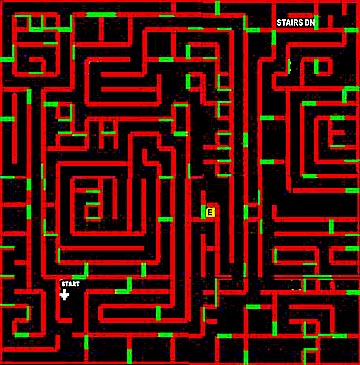
All of the maps on this page are shown in the same orientation as they appear in Swords of Glass: with north pointing up and west to the left. The dungeons are stacked on top of each other with level 1 at the top and located immediately below the text-based city in which you start the game. Each dungeon is 25 by 25 squares in size. If we assume a character stride of 3 feet, that gives each dungeon the dimensions of 75 by 75-feet. Not huge but believe me, that's plenty of room in which to get lost or horribly killed. The squares that make up each dungeon are laid out on a coordinate system with X=0 and Y=0 located on the upper left corner. The lowest right corner is X=24, Y=24. This is important to know because the mapa, pocomudar and mudar spells all use coordinates. Additionally, many messages tell you where treasures or weapons are located using this system. The "start" point where you enter the game is located at X=4, Y=19 near the lower left area of the map. There is another set of stairs that go down to level 2 in the upper right section of the map. The yellow square with an "E" inside it is an elevator. Pressing "A" leaves you on level 1, "B" takes you to 2, "C" to three and "D" to 4.
Be warned that ten percent of level one is in darkness, meaning that you won't be able to see anything.
A good way to use this and the following maps is to copy them into photo processing software like Photoshop, invert the colors so the dark areas or now white print them out on white cardstock. This provides a durable map on which you can make notes about what you discover.
Like all of the dungeons, level one is filled with many features and monsters. The following screen shots provide you with an idea of what you'll encounter.
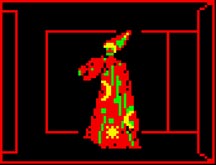 Alchemist. Killing him awards you 95 experience points. The same
image is used for a Robed Figure, 75 points. Many of the same images
are used on different levels but given different names and experience
point values.)
Alchemist. Killing him awards you 95 experience points. The same
image is used for a Robed Figure, 75 points. Many of the same images
are used on different levels but given different names and experience
point values.)
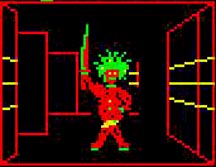 Brawler, 123 points (The same image is used for a cutthroat, who is
worth 113 points.)
Brawler, 123 points (The same image is used for a cutthroat, who is
worth 113 points.)
 Bruiser, 93 points
Bruiser, 93 points
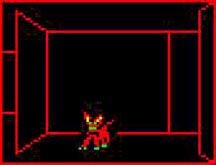 Dog, 76 points (Also rodent, 33 points, and weasel, 56 points.)
Dog, 76 points (Also rodent, 33 points, and weasel, 56 points.)
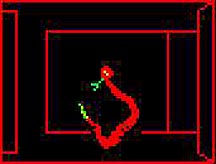 Garter snake, 43 points (And rattle snake, 189 points.)
Garter snake, 43 points (And rattle snake, 189 points.)
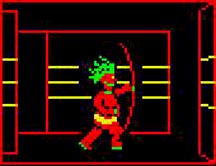 Hunter, 130 points
Hunter, 130 points
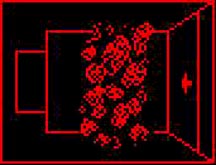 Roiling smoke, 89 points
Roiling smoke, 89 points
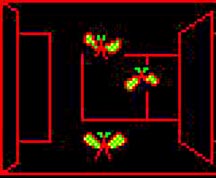 Swarm of flies, 110 points (Also a swarm of Giant bees, 98 points.)
Swarm of flies, 110 points (Also a swarm of Giant bees, 98 points.)
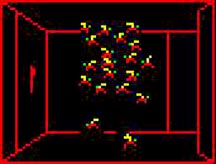 Swarm of gnats, 150 points
Swarm of gnats, 150 points
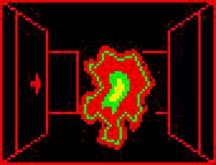 Ooze, 87 points
Ooze, 87 points
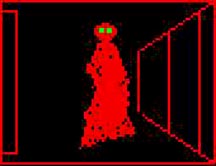 Insubstantial form, 140 points
Insubstantial form, 140 points
There
is also something called a Wispy shape, but I've never encountered
it. The experience points are important because by collecting them
you increase the level of your character and in so doing increase his
strength, dexterity and intelligence.
Monsters aren't the only things you'll find.
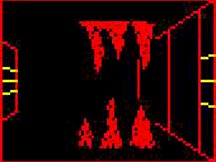 Walking into stalactites can injure you if you don't have enough protection.
Walking into stalactites can injure you if you don't have enough protection.
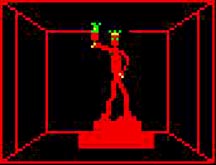 Statues usually give you the option off finding out where there is
treasure or stairs.
Statues usually give you the option off finding out where there is
treasure or stairs.
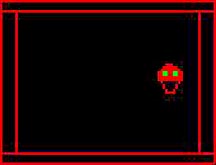 Gargoyles, walking into one costs you a hit point. I haven't figured
out how to kill one of these and indeed, it may not be possible.
Gargoyles, walking into one costs you a hit point. I haven't figured
out how to kill one of these and indeed, it may not be possible.
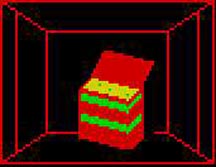 Walk into a treasure and you walk away with gold. The lower the level
or the harder it is to get to usually means there will be more gold
in the chest. Sometime there is also a weapon or other artifact
included. Again, the harder locations to get to usually mean the
artifact will be more valuable and useful. Unfortunately, artifacts
do not appear on the screen.)
Walk into a treasure and you walk away with gold. The lower the level
or the harder it is to get to usually means there will be more gold
in the chest. Sometime there is also a weapon or other artifact
included. Again, the harder locations to get to usually mean the
artifact will be more valuable and useful. Unfortunately, artifacts
do not appear on the screen.)
Note: the screen-capture process I used unfortunately altered some of the colors in the images.
You can find a much more detailed map of level 1 on the Map page of Dean Tersigni's The Glass Shrine.
LEVEL 2
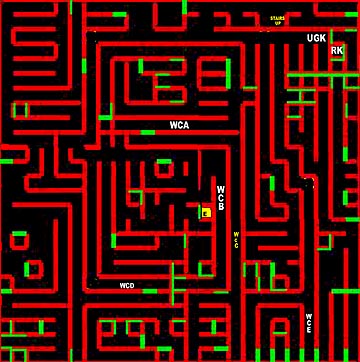
Level 2 has at least five places where as you walk over a certain spot the walls change. It's very disorienting. Here's what happens:

...You're
walking ..............to
this.........
along
a corredor..............................
when
the walls..............................
change
from this..............................
This may not be a bad thing in that it may make it easier for you to get where you want to go... or maybe not. The spots marked WCA, WCB, WCC, WCD and WCE are the locations I've found where the walls change. Spend enough time in this dungeon and I'm sure you find more.
The "UGK" and "RK" mean to use a green key or red key to unlock a door.
Here are few of the nasties you're likely to encounter in this dungeon:
 Land shark, 290 points
Land shark, 290 points
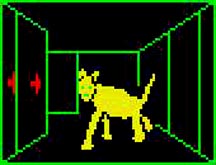 Large cat, 324 points
Large cat, 324 points
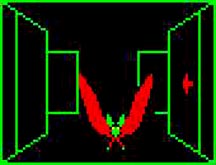 Vampire bat, 324 points
Vampire bat, 324 points
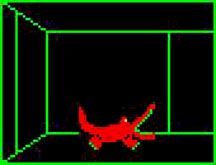 Crocodile, 256 points
Crocodile, 256 points
LEVEL 3
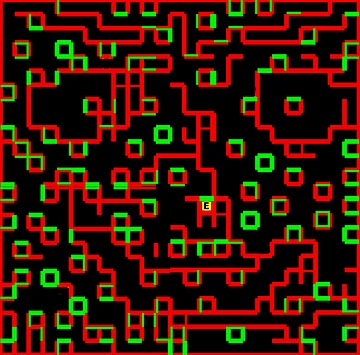
Back away from your monitor and look at the entire map rather than a small part of it and you'll see that the creators of Swords of Glass decided to have a little fun with the dungeon design. There's a vague outline of a smiling face in the layout of the walls. See it? The elevator is near the tip of his nose.
Many of the squares that are all doors make you dizzy when you walk in them because they spin you around so you're facing a different direction.
 Golum, 314 points
Golum, 314 points
 Alligator, 275 points
Alligator, 275 points
 Smog, 476 points
Smog, 476 points
 Crazed human, 286 points
Crazed human, 286 points
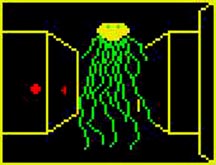 Jelly fish, 286 points
Jelly fish, 286 points
 Archer, 326 points
Archer, 326 points
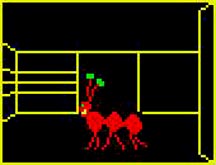 Giant ant, 246 points
Giant ant, 246 points
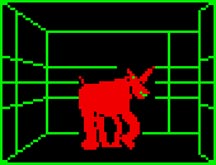 Rhinoceros, 357 points
Rhinoceros, 357 points
 Magic user, I've never been able to kill one of these guys so I don't
know what he's worth in experience points. What happened several
times was that I was trapped in a room with only one door and the
Magic user was on the other side. I couldn't hit him often enough
with my axe to have any effect and the door prevented me from casting
a spell at him. Three times I had to abandon a player because I was
hopelessly trapped this way. The teleportation spells Devancer,
Pocomudar or Mudar would be needed to escape situations such as this.
Magic user, I've never been able to kill one of these guys so I don't
know what he's worth in experience points. What happened several
times was that I was trapped in a room with only one door and the
Magic user was on the other side. I couldn't hit him often enough
with my axe to have any effect and the door prevented me from casting
a spell at him. Three times I had to abandon a player because I was
hopelessly trapped this way. The teleportation spells Devancer,
Pocomudar or Mudar would be needed to escape situations such as this.
LEVEL 4
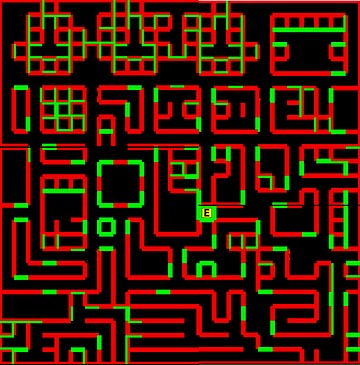
The three similar blocks of rooms at the top of the map are all nine-room puzzles with the clues in code. The two on the left require a green key to enter and the one on the middle-right requires a red ky. An Eye of Truth is needed to decypher the clues once you're inside.
I have spent hours working through the sets of clues provided to these puzzles and while I've been able to eliminate some of the rooms I've never managed to figure out solely from the clues where the treasures are. The problem is that each of the three puzzles have two doors with signs that say something like: "Either A is true or B is false." If other clues determine that this statement is false then there are so many ways it could be false that working through them all is impossible. Consider:
"Either A is true or B is false."
If this statement is false then there are five different ways it can be false:
Either A is true or B is true.
Either A is false or B is false.
A is true and B is false.
A is false and B is false.
A is true and B is true.
The instructions provided never clarify whether a statement like this can be made false by the falsity acting only on the true or false statements or if the overall statement can also be rendered false by the falsity acting on the "or" part of the statement by turning it into and "and." In this case the puzzle is logically underdefined and unsolvable. (There's probably some genius out there laughing at me right now for not being smart enough to solve these things.)
Even knowing where the treasure is doesn't help much. It's as if the game writers selected which rooms would be empty, have fire or treasure and wrote up the clues to be consistent with their locations, but never examined the clues to make sure the treasure could be found using them. For these reasons I consider these puzzles unfair. Anyone sharing this opinion can scroll down to the bottom of this page where I've posted the rooms where the treasure is located.
Another thing that's unfair about these puzzles is that considering how hard they are it's disappointing that all you get from solving them is gold, not artifacts.
One positive note is that if you boost your defense up to above 500 the rooms with fire I visited only nail you for 46 hit points. If you have enough to survive this and a cure potion or spell you can recover and continue treasure hunting.
There must be a way to get down to level 5 from level 4 but I've never discovered where it is.
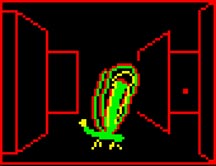 Mosquito, 422 points
Mosquito, 422 points
 King cobra, 345 points
King cobra, 345 points
 Squid, 324 points
Squid, 324 points
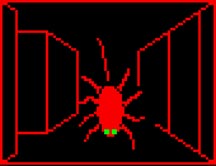 Giant spider, 342 points
Giant spider, 342 points
 Dragon larva, 356 points
Dragon larva, 356 points
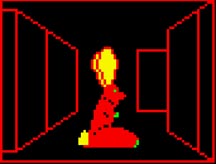 Rabbit, 459 points
Rabbit, 459 points
 Giant ameba, 579 points
Giant ameba, 579 points
 No-see-ums, 187 points
No-see-ums, 187 points
 Cougar, 524 points
Cougar, 524 points
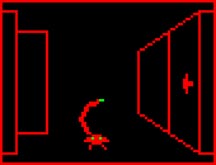 Scorpion, 487 points
Scorpion, 487 points
A
final warning about level 4, there are many pits with poisoned
spikes in them that impale you. (I
hate it when that happens.)
LEVEL 5
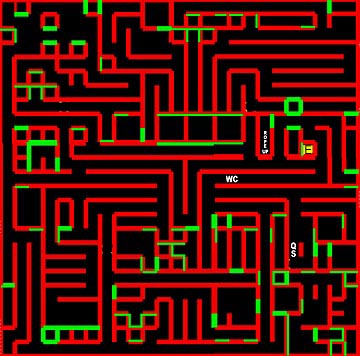
The WC refers to a spot where the walls change. The QS means quick sand. You can get out of it by throwing away almost everything you have. The small "rope up"
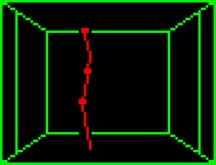
near the elevator suggests a way to get back up to level 4 but when I tried it the rope broke. When I visited the corresponding coordinates on level 4 there was no rope going down. The yellow square with an "E" in it on the right hand area of the map is an elevator going down. Pressing "A" takes you to level 5, "B" takes you to 6, "C" to 7 and "D" to 8.
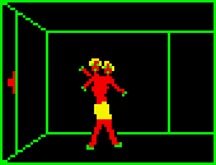 Mutant, 324 points
Mutant, 324 points
 Man-o-war, 436 points
Man-o-war, 436 points
LEVEL 6
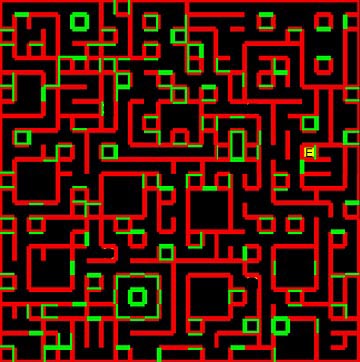
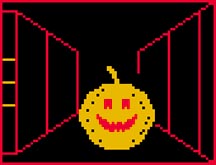 Jack O' Lantern, 551 points
Jack O' Lantern, 551 points
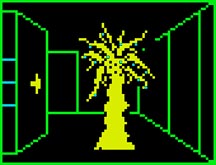 Walking tree, 589 points
Walking tree, 589 points
 Storm cloud, 746
Storm cloud, 746
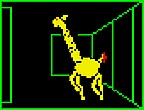 Giraffe, 642 points
Giraffe, 642 points
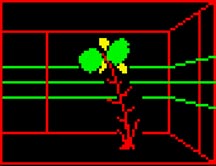 Killer weed, 546 points (There are also some Venus people plants on
this level.)
Killer weed, 546 points (There are also some Venus people plants on
this level.)
 Translucent image, 679 points
Translucent image, 679 points
 Rabid dog, 434 points
Rabid dog, 434 points
 Giant scorpion, 654 points
Giant scorpion, 654 points
 Wise octopus, 624 points
Wise octopus, 624 points
 Elusive archer, 359 points
Elusive archer, 359 points
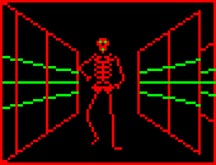 Skeleton, 567 points
Skeleton, 567 points
 Albino tiger, 740 points
Albino tiger, 740 points
LEVEL 7
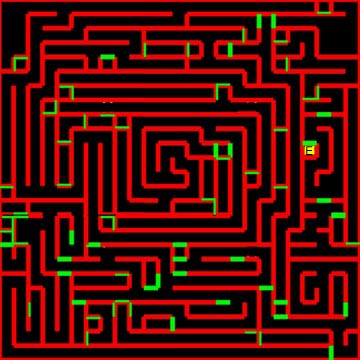
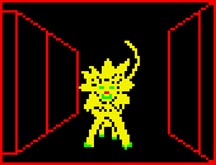 Lion, 702 points
Lion, 702 points
 Moving bones, 670 points
Moving bones, 670 points
 Killer weed, 1223 points (also the Venus people plant, 546 points)
Killer weed, 1223 points (also the Venus people plant, 546 points)
 Giant slime, 546 points
Giant slime, 546 points
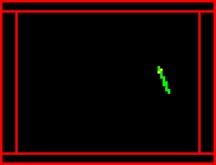 Leach, can't be killed. If you walk into it it'll make you sick.
Leach, can't be killed. If you walk into it it'll make you sick.
 Seasoned warrior, 1542 points
Seasoned warrior, 1542 points
 Foul smelling gas, 970 points
Foul smelling gas, 970 points
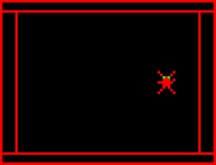 Wall spider, same as the leach. Some of these will get you even if
you don't walk into them.
Wall spider, same as the leach. Some of these will get you even if
you don't walk into them.
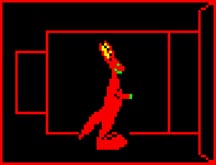 Kangaroo, 450 points
Kangaroo, 450 points
 Pterodactyl, 1020 points
Pterodactyl, 1020 points
 Sorcerer, 650 points
Sorcerer, 650 points
Level 8
Level 8 is a nightmare because its map changes every time you enter it. The following six images of the area around the elevator show this:

I've visited this level dozens of times and never found the same layout duplicated. Evidently the creators of Swords of Glass added a randomness generator to the map algorithm for this level. As bad as this looks, there is some hope. Focus on the rooms immediately surrounding the elevator and you'll notice some of them are the same in all the pictures. Evidently some of the features on level 8 are constant while others vary. I made three complete maps of this dungeon and compared them to see which areas are always the same. In the map that follows the grey areas are those that are constant:
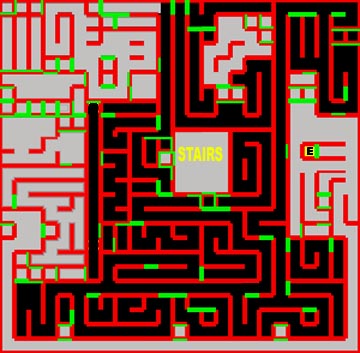
My recommendation would be only travel the constant areas, making notes about hazards and treasures. Hopefully all the good stuff is in this zone. Somewhere on this level is the Sword of Glass itself... good hunting!
 Killer weed, 1223 points There are dozens of these things on this
level. (also the Venus people plant, 546 points)
Killer weed, 1223 points There are dozens of these things on this
level. (also the Venus people plant, 546 points)
 Teste flies, 1670 points
Teste flies, 1670 points
 Lion, 702 points
Lion, 702 points
 Moving bones, 670 points
Moving bones, 670 points
 Yup, there are lots of leachs on this level... almost as many as
there are wall spiders.
Yup, there are lots of leachs on this level... almost as many as
there are wall spiders.
 Seasoned warrior, 1542 points
Seasoned warrior, 1542 points
 Foul smelling gas, 970 points
Foul smelling gas, 970 points
 Wall spider, same as the leach. Some of these will get you even if
you don't walk into them.
Wall spider, same as the leach. Some of these will get you even if
you don't walk into them.
 Pterodactyl, 1020 points
Pterodactyl, 1020 points
 Sorcerer, 650 points (Also Wizard apprentice, 2133 points)
Sorcerer, 650 points (Also Wizard apprentice, 2133 points)
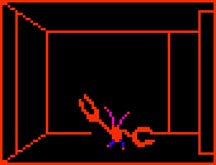 Mutant cockroach, 2560 points
Mutant cockroach, 2560 points
 Were-rhinoceros, 2300 points
Were-rhinoceros, 2300 points
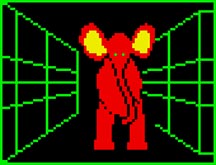 Rogue elephant, 972 points
Rogue elephant, 972 points
 Giant coral snake, 1982 (In some areas these things come at your
three and four at a time.)
Giant coral snake, 1982 (In some areas these things come at your
three and four at a time.)
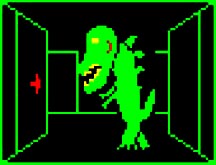 Tyrannosaurus, 2942 points
Tyrannosaurus, 2942 points
 Furball with teeth, 457 points
Furball with teeth, 457 points
 Raunchy Giraffe, 632 points
Raunchy Giraffe, 632 points
 Demon, 2349 points
Demon, 2349 points
Once
I found a Jewel:
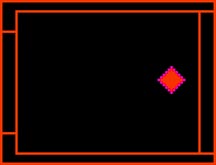
and was able to get it by walking into it. Unfortunately, I was horribly destroyed in a burning room before I could get back to the Temple to learn what it does. I found it in the changing area so unfortunately this indicates some of the better treasures are located in it. (Rats.)
Trivia
and Hints:
A "diadem" is head armour slightly less powerful than a crown.
Many times I get a message saying: "You hear a hideous sucking sound." This is a sign that quicksand is close.
Avoid wasting spells and potions by driving strength beyond 100. It doesn't seem to matter and it's very common in level 6, 7 and especially 8 to hit areas were almost every step you take robs you of your strength. Using resources to keep strength up in the high hundreds quickly uses up those resources. An exception is when you venture in the lair of dragons. They take a lot of hits to kill so load up on the strength to around 400.
"Mapa" is almost as useful as a map because it tells you your location and in which direction you are facing. This can be critical if you want to make sure you don't step in the wrong direction where a known trap exists.
Teleports sometimes go wrong and you get sent to an unknown location. This happens more often with pocomudar than mudar. After several uses on level one, mudar started sending me to unknown locations every time. Perhaps it can only be used a limited number of times on a given level.
If you have potions or spells that can increase your strength, you can use any weapon you want even if your character is only level 1. Just get the weapon, say an ax which takes 35 strength, and when you start playing increase your strength above 35 and you'll be able to use it.
Shooting a bow and casting spells never seem to miss but they can't shoot through doors. This is critical because many times something will attack you through a door you're trying to walk through. And hand weapon can strike through doors so be sure to have one.
To maximize the number of artifacts you can collect, try getting rid of all your armor and use amparo potion or the masamparo spell to boost your defense to 200 or so. The problem with this is if you get trapped and can't use potions or spells all your defense may melt away before you can reboost it. If there are any unfriendlies around they could gnaw away on you until you die.
Devancer is the only teleport that works in level 8 and it's critical to have because using it is the only way to escape many of the traps on that level.
One of the great things about the teleport spells is that if they drop you into a room that normally has some sort of horrible death-dealing hazard, that hazard won't be activated. To do so you'd have to exit the room and then re-enter it. Unfortunately the same is true for any treasure in the room.
The elevator to Level 3 drops you off in a walled area that you can get out of but can't get back into unless you have a teleport spell so plan where you travel very carefully. There may be another way out of that level but I haven't found it yet.
Several doors in Level 8 warn you that you are about to enter a construction zone and a hard hat is required. If you don't have some sort of head protection you won't be allowed access. The problem is that on two occasions this ended up getting me trapped because I didn't have a helmet so I couldn't go forward and the way back out was blocked by some horrible beast that I couldn't defeat.
Swords of Glass was written way back around 1984-85 and released in 1986. Back then processing speeds were so slow and memories so small that programmers had to be very efficient in writing their programs. For example, Swords of Glass only uses 391 Kilobytes - and that's "after" it's been unzipped. That's 1/6000th of a World of Warcraft game.
Back then computer mice were almost unheard of, which is why it was written for keypunching.
DVDs for storage had not even been thought of and CDs weren't mainstream yet. Most games were being written for storage on floppy disks, thin sheets of plastic with magnetic tape material painted on them.
Swords of Glass was never sold as an individual game. It was only available bundled with many other games. As CDs started appearing it could be found buried in a mix of over 20 games on a single CD.
To this date (2014) no one knows who wrote Swords of Glass.
While there are hundreds of monsters in Swords of Glass, the biggest danger isn't from a giant spider or monsterous scorpion, but from the mazes that make up the eight levels in the game. Twisting passages, one-way doors and changing tunnels get your character lost time and again.
In Utility, Wait (set at 1500) determines how long in milliseconds a message remains on screen so it can be read. The default is 1.5 seconds. I've tried setting this to a very high number to make the messages remain on long enough to be read when running the game in Windows but it didn't help. That's because the highest number the software can accept only works out to 1/3-second on a 3GH machine.
In Utility, Quick Plot turns off and on the little overhead projection of where you are in a dungeon.
Also in Utility, if you are paralyzed, hitting the "mons" letter "N" many times speeds healing.
In the Vault, JDE Manptn is a potion that will revive a character named JDE. Changing the JDE to the name of one of your characters may enable this potion to revive him or her. All revival potions are named after the character they can revive.
(Note: the last four explanations were graciously provided by Dean Tersigni. Thanks Dean!)
Download Sources:
In addition to The Glass Shrine, Swords of Glass can also be downloaded from the following sites:
www.old-games.com/download/4075/swords-of-glass
www.myabandonware.com/game/swords-of-glass-2eq
www.squakenet.com/download/swords-of-glass/7136
In
Conclusion:
These maps, monsters and hints may help you survive Swords of Glass should you attempt to play this classic game, but in this game there are no guarantees so beware! Also realize that there are many more villains to fear and treasures to discover than what's listed on this page. Most important, of course, is the great "Sword of Glass" itself.
I hope you found this page interesting and helpful. If you haven't yet visited his page, please be sure to check out Dean Tersigni's The Glass Shrine. My page wouldn't have been possible without Dean's and even after playing the game many hours I still refer to his outstanding pages.
Super Cheating Hints Caution! Enter at your own risk. This page contains spoilers. UPDATED!!!
Scroll down to learn the rooms in the three puzzles on level 4 that have treasure.
.
.
.
.
.
.
First nine rooms on the far left: treasure is in room 7
Second nine rooms just to the right of the first nine-room puzzle: treasure is in room 8.
The third nine-room puzzle on the middle left: treasure is in room 2.